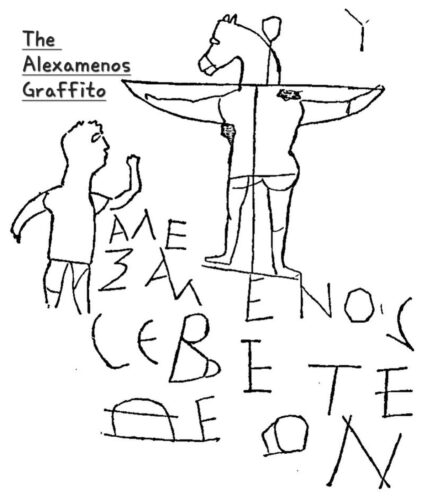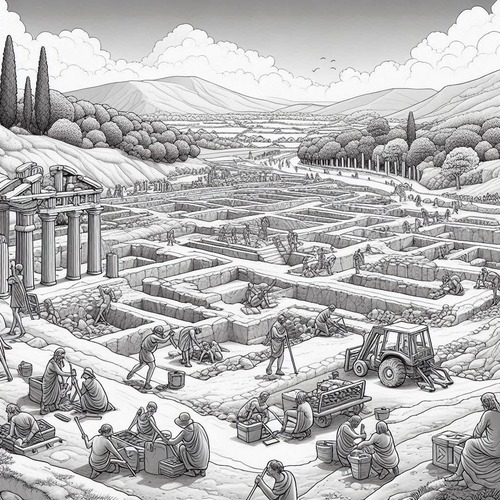Ten Discoveries That Support New Testament Reliability
For centuries, sceptics have questioned the historical accuracy of the New Testament. However, modern archaeological discoveries continue to validate Bible accounts, providing tangible evidence of the New Testament’s historical reliability. From ancient manuscripts to stone inscriptions, these archaeological findings offer compelling support for the accuracy of Bible narratives. Here are ten remarkable discoveries that have transformed our understanding of New Testament reliability.
The John Rylands Fragment (P52): The P52 fragment, also known as the John Rylands Papyrus 457, represents a pivotal discovery in biblical archaeology. Dated to approximately 125-175 CE, this small fragment contains portions of John 18:31-33 and 37-38, making it the oldest known New Testament manuscript. Its significance extends beyond its age—the fragment’s early dating definitively disproved Ferdinand Christian Baur’s theory that John’s Gospel was written in the late second century. Found in Egypt, far from its likely place of composition, P52 demonstrates the rapid dissemination of John’s Gospel throughout the ancient world, suggesting an even earlier original composition date.
Codex Sinaiticus: Discovered in Saint Catherine’s Monastery at Mount Sinai, the Codex Sinaiticus stands as the oldest complete New Testament manuscript in existence. Created in the fourth century CE, this remarkable codex contains the entire Bible from Genesis to Revelation, providing invaluable insights into early Christian textual transmission. Its excellent preservation and comprehensive content make it a cornerstone for understanding biblical textual history. The manuscript’s professional scribal quality and careful corrections demonstrate the early Christian community’s commitment to accurate scripture preservation.
Papyrus 66 (P66): Dating to around 200 CE, P66 contains a substantial portion of John’s Gospel, making it one of the most significant early Bible manuscripts. This papyrus, preserved in remarkably good condition, provides crucial evidence for the stability of New Testament text throughout generations of copying. Its early date and extensive content allow scholars to verify the consistency of John’s Gospel across centuries of transmission. The manuscript’s professional scribal features suggest it was produced for church use. This indicates organised Christian communities invested in accurate scripture preservation.
Dead Sea Scrolls: While primarily containing Old Testament texts, the Dead Sea Scrolls provide invaluable context for New Testament reliability. Discovered between 1947 and 1956 in the Qumran caves, these scrolls include prophecies and religious texts that illuminate the Jewish religious environment during Jesus’s time. The scrolls demonstrate remarkable textual preservation over millennia and provide historical context for many New Testament concepts and practices. Their content confirms the accuracy of biblical transmission and helps validate Old Testament prophecies referenced in the New Testament.
The Pilate Stone: Discovered in 1961 in Caesarea, this limestone block provides definitive archaeological evidence for Pontius Pilate’s historical existence. The inscription identifies Pilate as the “Prefect of Judea,” confirming the New Testament’s accurate portrayal of this crucial historical figure. This discovery silenced critics who had questioned Pilate’s historical reality and demonstrated the New Testament’s precision in recording political titles and administrative details of first-century Judea.
Josephus’s Historical Records: Though not an artefact in the traditional sense, the writings of Flavius Josephus provide crucial external historical verification for New Testament accounts. As a first-century Jewish historian, Josephus references Jesus, John the Baptist, James (Jesus’s brother), and other New Testament figures in his works Antiquities of the Jews and The Jewish War. His independent historical accounts corroborate numerous New Testament details about first-century Judea’s political and religious climate, providing valuable external validation of biblical narratives.
Jewish Ossuaries: These ancient bone boxes provide compelling archaeological evidence for New Testament reliability. Most notably, the James Ossuary, discovered in Jerusalem, bears the inscription “James, son of Joseph, brother of Jesus.” While controversy initially surrounded its authentication, scientific testing has supported its first-century dating. Additionally, numerous other ossuaries confirm the accuracy of New Testament-era naming conventions and burial practices. These discoveries demonstrate the historical accuracy of biblical descriptions of Jewish burial customs and validate the existence of key biblical figures.
GA 777 Manuscript: This medieval manuscript represents a crucial link in understanding the New Testament’s textual transmission. Containing significant portions of the Gospels, GA 777 demonstrates remarkable consistency with earlier manuscripts despite centuries of separation. Its careful preservation and textual alignment with older documents support the reliability of New Testament transmission through the medieval period. The manuscript’s systematic organisation and professional scribal features reflect the continued commitment to accurate biblical preservation.
Stone Tablets and Early Writing Materials: The evolution of writing materials from stone tablets to scrolls and finally to codices provides important context for New Testament transmission. Archaeological evidence shows early Christians pioneered the adoption of the codex format, which offered significant advantages over scrolls:
- Greater durability and portability
- Easier reference and cross-referencing
- More efficient use of writing material
- Better preservation of text
This technological transition helps explain the extraordinary preservation of New Testament texts compared to other ancient documents.
The Alexamenos Graffito: Discovered on Palatine Hill in Rome, this ancient graffiti (see image above) from around 200 CE depicts a crucified figure with a donkey’s head and the inscription “Alexamenos worships his god.” While mocking in nature, this artefact provides early non-Christian evidence of:
- The crucifixion’s central role in early Christianity
- The rapid spread of Christianity to Rome
- Early pagan understanding of Christian beliefs
- The social challenges faced by early Christians
This unintentional historical evidence supports the New Testament’s account of Christianity’s early spread and persecution.
Conclusion
The abundance and diversity of archaeological evidence supporting New Testament reliability continues to grow. From ancient manuscripts to physical artefacts, each discovery adds to a compelling body of evidence that validates biblical accounts. While no single artefact proves everything, the cumulative weight of these discoveries provides strong support for the New Testament’s historical reliability. These findings demonstrate the New Testament documents aren’t merely religious texts but are firmly grounded in verifiable historical events and contexts.
Modern archaeology has repeatedly confirmed biblical descriptions of places, people, and events, often in surprisingly specific details. As new technologies enable more sophisticated analysis and as new discoveries continue to emerge, the archaeological evidence supporting New Testament reliability grows stronger. For those seeking historical evidence for the Bible’s reliability, these ten discoveries offer compelling support for the accuracy and authenticity of New Testament accounts.
Ten Discoveries Support New Testament Reliability—Related FAQs
Why is the P52 (John Rylands) fragment so significant for dating the Gospel of John? The P52 fragment, dated to 125-175 CE, proves that John’s Gospel was being copied and circulated in Egypt far from its origin point during the early second century. This early dating definitively disproved sceptical theories that John’s Gospel was written in the late second century, as it would have been impossible for the text to be composed, copied, and transported to Egypt in such a short time. The fragment’s existence suggests the original Gospel was written much earlier, likely within the first century.
- How do the Dead Sea Scrolls support New Testament reliability when they don’t contain New Testament texts? The Dead Sea Scrolls validate the New Testament in several indirect but crucial ways. They demonstrate the remarkable accuracy of Jewish scribal transmission, showing how carefully ancient texts were preserved over centuries. Additionally, they provide invaluable context about Jewish beliefs and practices during Jesus’s time, confirming the New Testament’s accurate portrayal of first-century Jewish life and thought.
- What makes Josephus’s writings particularly valuable for confirming New Testament reliability? Josephus provides independent, non-Christian confirmation of key New Testament figures and events, including Jesus, John the Baptist, James, and Pontius Pilate. As a first-century Jewish historian writing for a Roman audience, his works offer unbiased historical context and verification of the New Testament’s accuracy in describing the political and social environment of first-century Judea.
Why is the Pilate Stone considered such important evidence? The Pilate Stone, discovered in 1961, provides definitive archaeological proof of Pontius Pilate’s role as prefect of Judea, exactly as described in the Gospels. This inscription not only confirms the historical existence of this crucial New Testament figure but also demonstrates the Gospels’ accuracy in recording specific political titles and administrative details of first-century Roman governance.
How does the evolution from stone tablets to codices support New Testament reliability? The early Christian adoption of the codex format over scrolls demonstrates sophisticated preservation methods that contributed to textual accuracy. The codex format, as seen in examples like Codex Sinaiticus, allowed for better preservation, easier cross-referencing, and more efficient copying, which helped maintain textual integrity across generations.
What makes the Alexamenos Graffito significant despite being anti-Christian? The Alexamenos Graffito, though mocking in nature, provides crucial non-Christian evidence of early Christian beliefs and practices. Its existence in Rome around 200 CE confirms both the rapid spread of Christianity and the historical reality of Christian persecution, validating New Testament accounts of the faith’s early expansion and the challenges faced by early believers.
Why is the quantity of New Testament manuscripts significant compared to other ancient texts? With over 5,800 Greek manuscripts, including early examples like P66 and GA 777, the New Testament has exponentially more ancient copies than any other ancient text (Homer’s Iliad, the next best-documented, has only about 650 manuscripts). This abundance of manuscripts, spanning different centuries and regions, allows scholars to cross-reference and verify the consistency of the text, demonstrating remarkable preservation accuracy over time.
Ten Discoveries Support New Testament Reliability—Related
Editor's Pick

Should We Stop Using Male Pronouns for God? Why Do We Say No?
A friend of ours arrived eagerly at his first theology class in seminary. But he quickly discovered something troubling: the [...]

Did Old Testament Law Force Women to Marry their Rapists?
**Editor’s Note: This post is part of our series, ‘Satan’s Lies: Common Deceptions in the Church Today’… Viral misinformation abounds [...]

From Danvers To Nashville: Two Statements, One Biblical Vision
30 years separate the Danvers Statement on Biblical Manhood and Womanhood (1987) and the Nashville Statement on Human Sexuality (2017). [...]

The Nashville Statement: Why Affirm It Despite Media Backlash?
WHY DO REFORMED CHRISTIANS STAND BY THIS STATEMENT ON MARRIAGE AND GENDER? When the Nashville Statement was released in 2017, [...]

Who Is Belial? Solving The 2 Corinthians 6:15 Mystery
Belial: This name from the pages of Scripture chills the soul. Who is this mysterious figure Paul invokes in 2 [...]

Celibacy Or Castration: What Jesus Really Means in Matthew 19:12
One of Scripture's most shocking misinterpretations led theologian Origen to castrate himself in the third century. His tragic mistake? Taking [...]

Philippians 4:13: Did Paul Really Mean We Can Do ALL Things?
"I can do all things through Christ who strengthens me." It's on gym walls, graduation cards, and motivational posters everywhere. [...]

The Ordinary Means of Grace: Why Are They Indispensable?
ORDINARY MEANS FOR EXTRAORDINARY TRANSFORMATION What if God's most powerful work in believers' lives happens through the most ordinary activities? [...]

Is the Bible God’s Word? Or Does It Only Contain God’s Word?
The authority of Scripture stands at the crossroads of modern Christianity. While some argue the Bible merely contains God’s Word [...]

Will We Remember This Life in Heaven? What Isaiah 65:17 Means
"Will I remember my spouse in heaven? My children? Will the joy we shared on earth matter in eternity?" These [...]
SUPPORT US:
Feel the Holy Spirit's gentle nudge to partner with us?
Donate Online:
Account Name: TRUTHS TO DIE FOR FOUNDATION
Account Number: 10243565459
Bank IFSC: IDFB0043391
Bank Name: IDFC FIRST BANK






